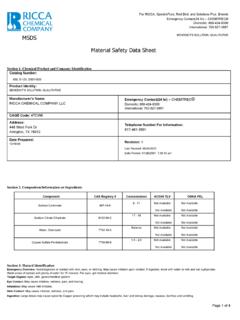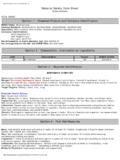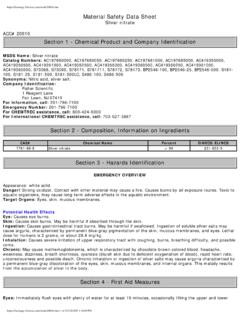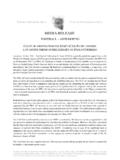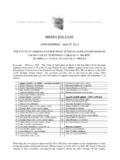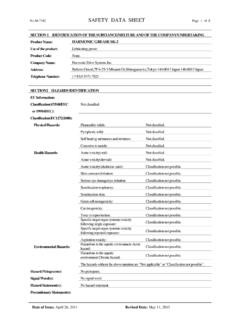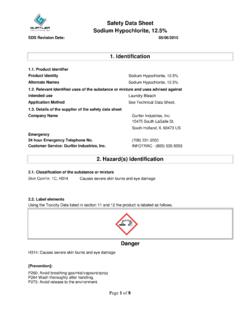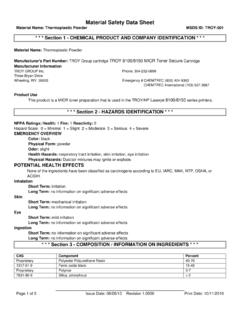Transcription of Material Safety Data Sheet Hyflo *Super-Cel* Filter …
1 Safety data Sheet Hyflo * super -Cel* Filter Aid ACC# 41143 Section 1 - Chemical Product and Company IdentificationMSDS Name: Hyflo * super -Cel* Filter Aid Catalog Numbers: H333-3, NC9840678 Synonyms: Infusorial earth Company Identification: Fisher Scientific 1 Reagent Lane Fair Lawn, NJ 07410 For information, call: 201-796-7100 Emergency Number: 201-796-7100 For CHEMTREC assistance, call: 800-424-9300 For International CHEMTREC assistance, call: 703-527-3887 Section 2 - Composition, Information on Ingredients CAS#Chemical NamePercentEINECS/ELINCS68855-54-9 Kieselguhr, soda ash flux-calcined100 272-489-014464-46-1 Silica, cristobalite<40 238-455-414808-60-7 Quartz<4 238-878-4 Section 3 - Hazards Identification EMERGENCY OVERVIEWA ppearance: light gray solid.
2 Caution! May cause eye, skin, and respiratory tract irritation. Contains trace amounts of quartz which may lead to fibrotic lung disease, silicosis or cancer. Target Organs: Lungs. Potential Health Effects Eye: May cause eye irritation. Skin: Dust may cause mechanical irritation. Ingestion: May cause irritation of the digestive tract. Inhalation: May cause respiratory tract irritation. Chronic: Prolonged exposure to respirable crystalline quartz may cause delayed lung injury/fibrosis (silicosis). Section 4 - First Aid Measures Eyes: Flush eyes with plenty of water for at least 15 minutes, occasionally lifting the upper and lower eyelids.
3 Get medical aid. Skin: Get medical aid if irritation develops or persists. Wash clothing before reuse. Flush skin with plenty of soap and water. Ingestion: If victim is conscious and alert, give 2-4 cupfuls of milk or water. Never give anything by mouth to an unconscious person. Get medical aid. Get medical aid if irritation or symptoms occur. Inhalation: Remove from exposure and move to fresh air immediately. If not breathing, give artificial respiration. If breathing is difficult, give oxygen. Get medical aid. Notes to Physician: No specific antidote exists.
4 Treat symptomatically and supportively. (1 of 5)7/23/2007 12:58:13 5 - Fire Fighting Measures General Information: As in any fire, wear a self-contained breathing apparatus in pressure-demand, MSHA/NIOSH (approved or equivalent), and full protective gear. During a fire, irritating and highly toxic gases may be generated by thermal decomposition or combustion. Extinguishing Media: Use extinguishing media most appropriate for the surrounding fire. Flash Point: Not applicable. Autoignition Temperature: Not applicable.
5 Explosion Limits, Lower:Not available. Upper: Not available. NFPA Rating: (estimated) Health: 1; Flammability: 0; Instability: 0 Section 6 - Accidental Release Measures General Information: Use proper personal protective equipment as indicated in Section 8. Spills/Leaks: Clean up spills immediately, observing precautions in the Protective Equipment section. Sweep up, then place into a suitable container for disposal. Avoid generating dusty conditions. Provide ventilation. Section 7 - Handling and Storage Handling: Wash thoroughly after handling.
6 Use with adequate ventilation. Minimize dust generation and accumulation. Avoid contact with skin and eyes. Avoid ingestion and inhalation. Storage: Store in a cool, dry, well-ventilated area away from incompatible substances. Section 8 - Exposure Controls, Personal Protection Engineering Controls: Use adequate general or local exhaust ventilation to keep airborne concentrations below the permissible exposure limits. Exposure Limits Chemical NameACGIHNIOSHOSHA - Final PELsKieselguhr, soda ash flux-calcined none listed none listed none listed Silica, cristobalite mg/m3 TWA (respirable fraction) 25 mg/m3 IDLH (respirable dust) none listed Quartz mg/m3 TWA (respirable fraction) mg/m3 TWA (respirable dust) 50 mg/m3 IDLH (respirable dust) none listed OSHA Vacated PELs: Kieselguhr, soda ash flux-calcined: No OSHA Vacated PELs are listed for this chemical.
7 Silica, cristobalite: mg/m3 TWA (respirable dust) Quartz: mg/m3 TWA (respirable dust) Personal Protective Equipment Eyes: Wear appropriate protective eyeglasses or chemical Safety goggles as described by OSHA's eye and face protection regulations in 29 CFR or European Standard EN166. Skin: Wear appropriate gloves to prevent skin exposure. Clothing: Wear appropriate protective clothing to minimize contact with skin. Respirators: Follow the OSHA respirator regulations found in 29 CFR or European Standard EN 149. Use a NIOSH/MSHA or European Standard EN 149 approved respirator if exposure limits are exceeded or if irritation or other symptoms are experienced.
8 (2 of 5)7/23/2007 12:58:13 9 - Physical and Chemical Properties Physical State: Solid Appearance: light gray Odor: odorless pH: 5-10 Vapor Pressure: 10 mm Hg @ 1732 deg C Vapor Density: Not available. Evaporation Rate:Not available. Viscosity: Not available. Boiling Point: 2230 deg C Freezing/Melting Point:1710 deg C Decomposition Temperature:Not available. Solubility: Insoluble in water Specific Gravity/ Molecular Formula:SiO2 Molecular Section 10 - Stability and Reactivity Chemical Stability: Stable under normal temperatures and pressures.
9 Conditions to Avoid: Dust generation. Incompatibilities with Other Materials: Hydrogen fluoride, strong acids. Hazardous Decomposition Products: None. Hazardous Polymerization: Will not occur. Section 11 - Toxicological Information RTECS#: CAS# 68855-54-9 unlisted. CAS# 14464-46-1: VV7325000 CAS# 14808-60-7: VV7330000 LD50/LC50: Not available. Not available. Not available. Carcinogenicity: CAS# 68855-54-9: Not listed by ACGIH, IARC, NTP, or CA Prop 65. CAS# 14464-46-1: l ACGIH: Not listed. l California: Not listed.
10 L NTP: Known carcinogen (listed as Silica, crystalline (general form)). l IARC: Group 1 carcinogenCAS# 14808-60-7: l ACGIH: A2 - Suspected Human Carcinogen l California: carcinogen, initial date 10/1/88 (airborne particles of respirable size) l NTP: Known carcinogen l IARC: Group 1 carcinogen (3 of 5)7/23/2007 12:58:13 : No information available. Teratogenicity: No information available. Reproductive Effects: No information available. Mutagenicity: No information available. Neurotoxicity: No information available.
